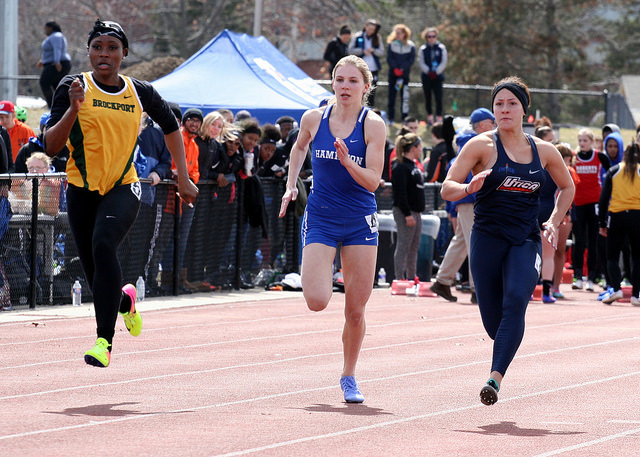
The Hamilton College women’s and men’s track teams are poised to follow up a record breaking indoor season with an equally successful outdoor season thanks to a handful of impactful frirst-years and seasoned veterans. During the indoor season, a combined ten school records were broken between the two squads, with both teams competing at Atlantic Regionals to cap off the season, and Eli Saucier ’18 of the men’s squad earning a spot at NCAA Nationals in Alabama.
Coming off such a strong indoor season, one may assume there would be some championship hangover, or fatigue setting in from training for six months straight. This is not the case, as the Continentals’ outdoor season got off to a strong start in Jacksonville, FL over the second week of spring break. Both teams trained hard for a week in Orlando before traveling to Jacksonville on Thursday, March 22, and competing the next day. Shorthanded, and going up against Division I competition like Clemson and Princeton, the Continentals ran well. Many people qualified for NESCAC championships at the meet, and Saucier even scored points in the 200 meter dash.
Carrying momentum from the Sunshine State, many Continentals have their eyes set on new personal bests and championships at the end of the season. Grace Heller ’19 shared that she hopes to “break 17:30 in the 5k and hit 36:30 in the 10k” while captain Hanna Jerome ’18 stated her wish to “have a top eight finish at the NESCAC championship, run a personal-best in the 1500m and 800m runs and have a lot of fun while doing so.” Cat Berry, standout junior for the women’s team has her sights set on another dominant run towards NESCACs, while breaking team event record as well. “I want to improve my standing at NESCACs and Regionals, as well as the team’s standing. I also hope to break some relay records in both the 4×100 and 4×400,” she says.
Enthusiasm and determination are equally present on the men’s team with captains Saucier, Henry Whipple ’18, and Peter DeWeirdt ’18 all expressing high hopes for the team. Saucier says “I expect to break my current sprint records and place on the podium at nationals,” while also describing his desire to “leave a positive impact on the underclassmen; being in a leadership position, I believe bringing this energy is very important in developing and sustaining a good team culture and work ethic.”
With those lofty goals in mind, the Continentals competed at SUNY Geneseo on March 31 in typical Upstate New York conditions: overcast, windy, and frigid. With wind speeds clocking in at thirty miles per hour and temperatures fluctuating between the low forties and high fifties, the Continentals faced steep competition on and off the track. This did not stop the men and women from competing hard, and though a few Continentals bowed out to injuries or tightness, more qualified for NESCACs and Atlantic Regionals at the end of the year. On the men’s side, Eric Wohl ’18 won the 3k steeplechase, Whipple got second in the 10k, Lucas Wright ’21 won the 800 meter dash, jumper Preston DeLaurentis ’18 won the triple jump, and thrower Ty Kunzman ’20 placed seventh in both the javelin and hammer throw. On the women’s side, Berry scored third in the 100 meter and won the 200 meter dash, Jerome placed fifth in the 800 meter dash, and Heller won the 10k.Additionally, the 4×100 meter relay — featuring the quartet of Berry, Emily Steates, ’19, Marie Steiner ’20, and Diamond Jackson ’21 finished second while thrower Emily Hull placed sixth in the hammer toss.
However, these triumphs have been somewhat tempered in the following days. The weather has not cooperated, causing the Continentals to cancel their home invitational this past weekend. With only six meets to qualify for NESCACs, the Continentals need every chance they can get to post fast times and jump or throw impressive marks. When asked about the transition from indoor to outdoor, Ryan Sedwick ’19 noted that, “the transition from indoor to outdoor has been very tough this year, mostly because there hasn’t really been a transition. Between all the cold weather and snow, we’re still stuck on the indoor track a lot of the time.” Other team members acknowledged the difficulties of running outdoors in cold temperatures, but found positives in the events changes that come with a bigger track. Heller views the transition as “very exciting” because her event group, the 5k runners, start with a “12 on the lap counter, instead of a 25.” When prompted to respond to the change in conditions, veteran captains Jerome and Saucier eschewed the weather and instead keyed in on the importance of maintaining continuity between the two seasons. “It’s important to think of it as one continuous season and take the hard work from our indoor season and let that boost us into the outdoor season,” Saucier notes.
Jerome subscribes to a similar training mindset: “I have always thought of Indoor track as a stepping-stone to Outdoor. During the winter months, teammates take the time to get a feel for the different events and decide where they will most achieve. Outdoor is a shorter season where we are prepared and ready to let all of the hard work pay off. I am very excited for what is to come.”

















